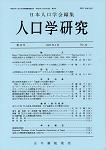Volume 24
Displaying 1-30 of 30 articles from this issue
- |<
- <
- 1
- >
- >|
Index
-
Article type: Cover
1999Volume 24 Pages Cover1-
Published: June 01, 1999
Released on J-STAGE: September 12, 2017
Download PDF (1405K) -
Article type: Index
1999Volume 24 Pages Toc1-
Published: June 01, 1999
Released on J-STAGE: September 12, 2017
Download PDF (1405K) -
Article type: Appendix
1999Volume 24 Pages App1-
Published: June 01, 1999
Released on J-STAGE: September 12, 2017
Download PDF (868K)
Article
-
Article type: Article
1999Volume 24 Pages 1-13
Published: June 01, 1999
Released on J-STAGE: September 12, 2017
Download PDF (2014K) -
Article type: Article
1999Volume 24 Pages 15-31
Published: June 01, 1999
Released on J-STAGE: September 12, 2017
Download PDF (2733K)
Note
-
Article type: Article
1999Volume 24 Pages 33-43
Published: June 01, 1999
Released on J-STAGE: September 12, 2017
Download PDF (1616K) -
Article type: Article
1999Volume 24 Pages 45-55
Published: June 01, 1999
Released on J-STAGE: September 12, 2017
Download PDF (1694K) -
Article type: Article
1999Volume 24 Pages 57-66
Published: June 01, 1999
Released on J-STAGE: September 12, 2017
Download PDF (1638K)
Scientific Information
-
Article type: Article
1999Volume 24 Pages 67-69
Published: June 01, 1999
Released on J-STAGE: September 12, 2017
Download PDF (516K)
Book Reviews
-
Article type: Article
1999Volume 24 Pages 70-
Published: June 01, 1999
Released on J-STAGE: September 12, 2017
Download PDF (291K) -
Article type: Article
1999Volume 24 Pages 71-
Published: June 01, 1999
Released on J-STAGE: September 12, 2017
Download PDF (247K) -
Article type: Article
1999Volume 24 Pages 72-
Published: June 01, 1999
Released on J-STAGE: September 12, 2017
Download PDF (258K) -
Article type: Article
1999Volume 24 Pages 73-
Published: June 01, 1999
Released on J-STAGE: September 12, 2017
Download PDF (251K) -
Article type: Article
1999Volume 24 Pages 73-
Published: June 01, 1999
Released on J-STAGE: September 12, 2017
Download PDF (251K) -
Article type: Appendix
1999Volume 24 Pages 73-
Published: June 01, 1999
Released on J-STAGE: September 12, 2017
Download PDF (160K)
In Memoriam
-
Article type: Article
1999Volume 24 Pages 74-
Published: June 01, 1999
Released on J-STAGE: September 12, 2017
Download PDF (317K)
PAJ Information
-
Article type: Article
1999Volume 24 Pages 75-
Published: June 01, 1999
Released on J-STAGE: September 12, 2017
Download PDF (232K) -
Article type: Article
1999Volume 24 Pages 75-
Published: June 01, 1999
Released on J-STAGE: September 12, 2017
Download PDF (233K) -
Article type: Article
1999Volume 24 Pages 75-
Published: June 01, 1999
Released on J-STAGE: September 12, 2017
Download PDF (233K) -
Article type: Article
1999Volume 24 Pages 76-
Published: June 01, 1999
Released on J-STAGE: September 12, 2017
Download PDF (218K) -
Article type: Appendix
1999Volume 24 Pages 76-
Published: June 01, 1999
Released on J-STAGE: September 12, 2017
Download PDF (141K) -
Article type: Appendix
1999Volume 24 Pages 77-
Published: June 01, 1999
Released on J-STAGE: September 12, 2017
Download PDF (60K) -
Article type: Appendix
1999Volume 24 Pages 78-84
Published: June 01, 1999
Released on J-STAGE: September 12, 2017
Download PDF (1161K) -
Article type: Appendix
1999Volume 24 Pages 85-
Published: June 01, 1999
Released on J-STAGE: September 12, 2017
Download PDF (122K) -
Article type: Appendix
1999Volume 24 Pages 86-87
Published: June 01, 1999
Released on J-STAGE: September 12, 2017
Download PDF (191K) -
Article type: Appendix
1999Volume 24 Pages 88-
Published: June 01, 1999
Released on J-STAGE: September 12, 2017
Download PDF (71K) -
Article type: Appendix
1999Volume 24 Pages 88-
Published: June 01, 1999
Released on J-STAGE: September 12, 2017
Download PDF (71K) -
Article type: Appendix
1999Volume 24 Pages App2-
Published: June 01, 1999
Released on J-STAGE: September 12, 2017
Download PDF (868K) -
Article type: Cover
1999Volume 24 Pages Cover2-
Published: June 01, 1999
Released on J-STAGE: September 12, 2017
Download PDF (953K) -
Article type: Index
1999Volume 24 Pages Toc2-
Published: June 01, 1999
Released on J-STAGE: September 12, 2017
Download PDF (953K)
- |<
- <
- 1
- >
- >|
